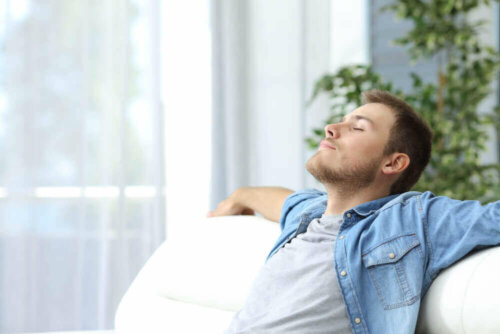Jacobson's Progressive Muscle Relaxation


Written and verified by the psychologist Loreto Martín
Many people are unable to control their stress even though they don’t have a clinical condition or nervousness or high anxiety levels. There are many different types of behavior and attitudes a person can adopt when they’re psychologically and emotionally overwhelmed. For instance, have you heard about Jacobson’s progressive muscle relaxation?
There are useful strategies to face this type of problem. One of them is fleeing the situation. The other one is finding a pleasant activity and focusing on it. It gets out of hand when it’s not possible to separate from a given situation. It could happen in a meeting, the subway, or when you’re home alone with small children.
These are the instances in which Jacobson’s progressive muscle relaxation can come in handy. The best part is it’s a simple and effective technique anyone can put into practice almost anywhere.
You have to learn how to do it first, though.
What’s the goal of progressive muscle relaxation?

Progressive muscle relaxation has two objectives: to teach you to identify your own physiological signals coming from the muscles when they’re under pressure and to put into action learned skills to reduce them.
All activation (anxiety, stress, etc) follows a curve: it has a progressively fast starting point that goes up until it reaches the maximum point of personal activation.
The human body goes out of control when it reaches its maximum and, consequently, we’ll lose control over the things we do and how we respond to our own anxiety.
In many cases, we dismiss the signs of stress by mistakenly believing that we can’t control activation or anxiety. Thus, we must be able to identify these signs to remain in control of ourselves.
There’s no need to reach maximum activation to start acting and implementing relaxation techniques. In fact, it’s almost impossible to apply a relaxation technique when you reach the peak of your stress.
Thus, you must take action as soon as you recognize the signals; use the technique we’re about to describe.
Like this article? We think you may also enjoy reading: 9 Tips to Clear Your Mind of Bad Thoughts
What does progressive muscle relaxation consist of?
Jacobson’s technique aims to achieve deep levels of relaxation and you can apply it to every muscle in your body.
In fact, tension and relaxation exercises can help you identify the level of muscular tension you’re experiencing.
The aim of these exercises, which require training, is to be able to tell what’s going on in your muscles when you’re subjected to stress.
For instance, you might frown, tense your thighs, and hands, or change position, among others when you begin to feel anxiety. You may not notice this tension in the different parts of your body but it’s there long before anxiety reaches its peak.
As you can see, knowing how to identify tension will help you keep the stress from skyrocketing.
How to train progressive muscle relaxation?

Jacobson’s progressive muscle relaxation requires training – at least the first few times – with a person who knows and masters the technique. Then, you can put it into practice at home. Firstly, you’ll need to find a comfortable place to do so
You’ll be able to practice it anywhere afterward, it’s only that training requires you to be comfortable. For example, you shouldn’t be sleepy, you shouldn’t do so after eating or when you know you could be interrupted. In general, the environment should be as peaceful and quiet as possible.
- Then, sit or lie down once you find the ideal place and begin to tense the muscles of your body, one by one, following the various muscle groups. To begin, tense every muscle for about five seconds and then relax them for twenty seconds.
- It’ll be complicated to control the times in the beginning. Thus, skip the counting and just focus on the tension of the muscle. Get someone to help you keep the time if there’s someone you trust nearby
- Do the same with every muscle until you go through all of them.
List of muscle groups to train
The muscle groups to tighten and relax are as follows.
Note: Some of these have a small explanation to try to facilitate the gesture -or tension- sought in that particular muscle:
- Dominant hand and forearm: clench the fist as if you wanted to punch something
- Dominant biceps: relax the hand by trying to join the wrist with the shoulder
- Non-dominant hand and forearm
- Non-dominant biceps
- Forehead: strongly raise your eyebrows
- Eyes: close and squeeze your eyes tightly
- Nose and upper cheeks: wrinkle the nose as if you were sniffing something disgusting
- Jaw, lower cheeks, and tongue: clench your teeth by pressing the tongue on your palate
- Neck and throat: try to touch your chin to your chest if you’re sitting down; press your head against the bed if you’re lying down
- Shoulders and upper back: try to touch your shoulders from behind
- Chest: take a deep breath and strongly blow out the air
- Abdomen: shrink your stomach inward as if someone was about to punch it
- Lower back: arch your back by pulling out your abdomen (this is more than just pushing your belly outwards)
- Dominant leg: stomp hard, as if you were stepping on a pedal, and stretch your leg with your foot out if you’re lying down
- Now do this with your non-dominant leg.
We think you may also find this article interesting: Mental Breakdowns – When the Mind and Body Reach Their Limits
Why’s training so important?

Relaxation and breathing techniques work if you actually do them. Furthermore, you’ll be wasting your time if you don’t bother to practice them. Ideally, you should do so twice a day for about twenty minutes.
The purpose of practicing is to train your brain to relax your muscles when there’s tension. Thus, you’ll be able to do so efficiently when it comes naturally.
When you train, tension will be followed by relaxation as your muscles begin to naturaly tense due to anxiety. Thus, anxiety will have a lower impact as your muscles “learn” how to relax on their own.
As you can see, you won’t need to tense and relax every muscle when anxiety strikes after you train your muscles to do so. They’ll do it on their own.
Final notes about Jacobson’s progressive muscle relaxation
You can conduct a training session in different contexts in the meantime.
For example, you could do these exercises in the subway if you become anxious there. Just clench your fist and unclench it, close your eyes tightly and open them, etc.
Progressive muscle relaxation not only trains your muscles to relax when they’re tense and reduces your levels of anxiety. It also increases your self-sufficiency as your body will opt for pleasure instead of anxiety and nervousness.
You’re now in possession of a most brilliant tool. Thus, you can say goodbye to that anxiety discomfort by properly training for and implementing progressive muscle relaxation.
All cited sources were thoroughly reviewed by our team to ensure their quality, reliability, currency, and validity. The bibliography of this article was considered reliable and of academic or scientific accuracy.
- Manzoni GM, Pagnini F, Castelnuovo G, Molinari E. Relaxation training for anxiety: a ten-years systematic review with meta-analysis. BMC Psychiatry. 2008;8:41. Published 2008 Jun 2. doi:10.1186/1471-244X-8-41
- Sundram BM, Dahlui M, Chinna K. Effectiveness of progressive muscle relaxation therapy as a worksite health promotion program in the automobile assembly line. Ind Health. 2016;54(3):204–214. doi:10.2486/indhealth.2014-0091
- Li Y, Wang R, Tang J, et al. Progressive muscle relaxation improves anxiety and depression of pulmonary arterial hypertension patients. Evid Based Complement Alternat Med. 2015;2015:792895. doi:10.1155/2015/792895
- Conrad, A., & Roth, W. T. (2007). Muscle relaxation therapy for anxiety disorders: It works but how? Journal of Anxiety Disorders, 21(3), 243–264. https://doi.org/10.1016/j.janxdis.2006.08.001
- Chellew, K., Evans, P., Fornes-Vives, J., Pérez, G., & Garcia-Banda, G. (2015). The effect of progressive muscle relaxation on daily cortisol secretion. Stress, 18(5), 538–544. https://doi.org/10.3109/10253890.2015.1053454
This text is provided for informational purposes only and does not replace consultation with a professional. If in doubt, consult your specialist.








